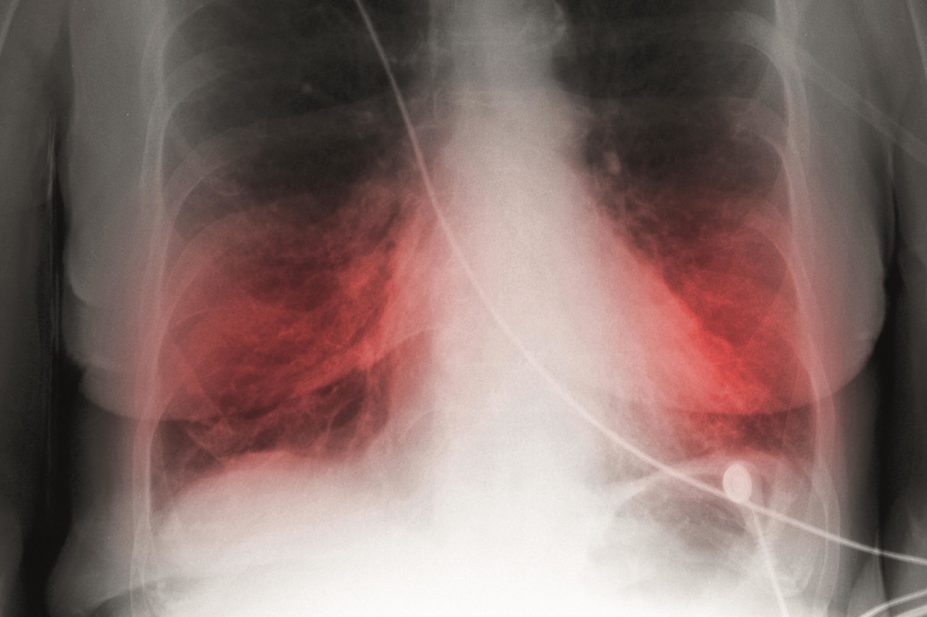
Cultura RM / Alamy Stock Photo
Combining the long-acting beta-agonist (LABA) indacaterol plus long-acting muscarinic antagonist (LAMA) glycopyrronium is more effective than salmeterol plus fluticasone in preventing exacerbations in patients with chronic obstructive pulmonary disease (COPD) who have a history of exacerbation during the previous year, a study shows.
Most clinical guidelines recommend a LABA plus an inhaled glucocorticoid or a LAMA as the first choice of treatment for COPD patients who are at high risk of an exacerbation.
Researchers set out to discover the impact of a combination LABA-LAMA treatment and whether it was non-inferior to salmeterol plus fluticasone in terms of the rate of all COPD exacerbations (mild/moderate/severe).
They recruited 3,362 COPD patients in 43 countries for the 52-week randomised double-blind FLAME trial, which was supported by Novartis.
Some 1,680 patients received LABA indacaterol (110 μg) plus the LAMA glycopyrronium (50 μg) once daily. Another 1,682 patients received the LABA salmeterol (50 μg) plus the inhaled glucocorticoid fluticasone (500 μg) twice daily. All patients had experienced at least one exacerbation in the previous 12 months.
Reporting their findings in the New England Journal of Medicine
[1]
(online, 15 May 2016), the researchers say: “We found that among patients with COPD who had a history of exacerbation during the previous year, indacaterol-glycopyrronium was consistently more effective than salmeterol-fluticasone in preventing exacerbations and was associated with no detectable increase in adverse events.”
The team found that the rate of exacerbations in the indacaterol-glycopyrronium group were 11% lower than patients in the salmeterol-fluticasone group (3.59 versus 4.03; rate ratio, 0.89; 95% confidence interval [CI], 0.83 to 0.96; P=0.003).
Patients in the indacaterol-glycopyrronium group also had a longer time until the first exacerbation than patients in the salmeterol-fluticasone group (71 days [95% CI, 60 to 82] vs. 51 days [95% CI, 46 to 57]; hazard ratio, 0.84 [95% CI, 0.78 to 0.91], representing a 16% lower risk; P<0.001).
The rate of moderate or severe exacerbations was also lower in the indacaterol-glycopyrronium group than in the salmeterol–fluticasone group (0.98 vs. 1.19; rate ratio, 0.83; 95% CI, 0.75 to 0.91; P<0.001).
In an accompanying editorial[2]
, James Donohue, a professor in pulmonary diseases and critical care at the University of North Carolina, says the results suggest that there is sufficient evidence to support doctors recommending a LABA–LAMA regimen over the use of a LABA–inhaled glucocorticoid regimen in high-risk patients with a history of exacerbations.
But he adds: “More trials – especially trials that have a longer duration, include more patients with severe disease and coexisting conditions, and examine additional biomarkers – are needed before we can be sure that the FLAME trial has cast a new light on the prevention of COPD exacerbations.”
Also commenting on the study, Richard Russell, an honorary medical adviser at the British Lung Foundation, says: “[The study] clearly shows that a combination of LABA and LAMA medication can be safely given to a population of high-risk patients instead of a LABA/inhaled corticosteroid (ICS) combination – the most widely used treatment in COPD at the present time.”
He adds: “The LABA/LAMA drug effect was significant and clearly outperformed the LABA/ICS treatment from a point of view of reduction in exacerbations. This was seen in mild, moderate or severe exacerbations.”
Darush Attar-Zadeh, respiratory lead pharmacist at the NHS Barnet Clinical Commissioning Group in London, says: “Within the pharmacy, we see lots of COPD patients with comorbidities as a result of their treatment, for which they may be prescribed many medications. Some of these patients will also be suffering exacerbation or worsening of their symptoms despite their current COPD treatment.
“[The study] highlights the need to consider alternative treatments in our assessment and management of these patients,” he adds.
References
[1] Jadwiga A. Wedzicha J A, Banerji D et al. Indacaterol-Glycopyrronium versus salmeterol-fluticasone for COPD. New England Journal of Medicine 2016. doi: 10.1056/NEJMoa1516385
[2] Donohue J F. Another choice for prevention of COPD exacerbations. New England Journal of Medicine 2016. doi: 10.1056/NEJMe1604444


